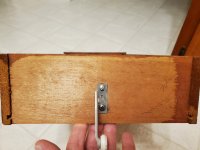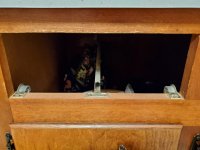Packard
Member
My friend is trying to sell is 1980s vintage mobile home (single wide). He has been painting the interior and making minor improvements.
He called me the other day and said, "Do you think you can repair one of the kitchen cabinet drawers?" I said, "Sure, just leave it on my front porch and I will take care of it when I get home".
I did not know even that this quality of cabinet existed. The sides and back are made from 1/2" thick particle board, the bottom appears to be made from a plywood door skin, and the drawer face is made from MDF. All butt joints and held in place with three narrow crown staples per joint. No glue anywhere.
If there was ever a finish applied to the drawer box, it evaporated years before. It all looks as though it never saw paint or clear coat of any kind.
Replicating the drawer face would be too difficult, so I salvaged that. I used 1/2" poplar and brad nails and glue for the sides, 1/4" plywood for the bottom and a piece of scrap 3/4" poplar for the rear.
I am not particularly proud of this repair, but I'm sure it will last longer than the original and certainly last until the mobile home gets sold.
I've also never seen this type of draw hardware. You have to lift the drawer front slightly to move it in or out.

He called me the other day and said, "Do you think you can repair one of the kitchen cabinet drawers?" I said, "Sure, just leave it on my front porch and I will take care of it when I get home".
I did not know even that this quality of cabinet existed. The sides and back are made from 1/2" thick particle board, the bottom appears to be made from a plywood door skin, and the drawer face is made from MDF. All butt joints and held in place with three narrow crown staples per joint. No glue anywhere.
If there was ever a finish applied to the drawer box, it evaporated years before. It all looks as though it never saw paint or clear coat of any kind.
Replicating the drawer face would be too difficult, so I salvaged that. I used 1/2" poplar and brad nails and glue for the sides, 1/4" plywood for the bottom and a piece of scrap 3/4" poplar for the rear.
I am not particularly proud of this repair, but I'm sure it will last longer than the original and certainly last until the mobile home gets sold.
I've also never seen this type of draw hardware. You have to lift the drawer front slightly to move it in or out.




